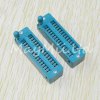Hello everyone!
I have a beginner question.
I've been trying to buy IC sockets so I can easily move my PIC chips around.
I think I should be buying DIP sockets, with 2.54mm pitch, and 7.5mm row to row spacing, correct? (For the relevant number of pins of course).
There seem to be numerous sockets around. Very confusing. I tried searching on Mouser and there are numerous listings for such sockets.
The photos don't seem to match the specifications either.
Any caution or other advice? I don't want to end up with a bag of sockets that are the wrong sizes.
I want to get sockets for my 18, 20, and 28 pin PICs.
Thanks.
I have a beginner question.
I've been trying to buy IC sockets so I can easily move my PIC chips around.
I think I should be buying DIP sockets, with 2.54mm pitch, and 7.5mm row to row spacing, correct? (For the relevant number of pins of course).
There seem to be numerous sockets around. Very confusing. I tried searching on Mouser and there are numerous listings for such sockets.
The photos don't seem to match the specifications either.
Any caution or other advice? I don't want to end up with a bag of sockets that are the wrong sizes.
I want to get sockets for my 18, 20, and 28 pin PICs.
Thanks.


